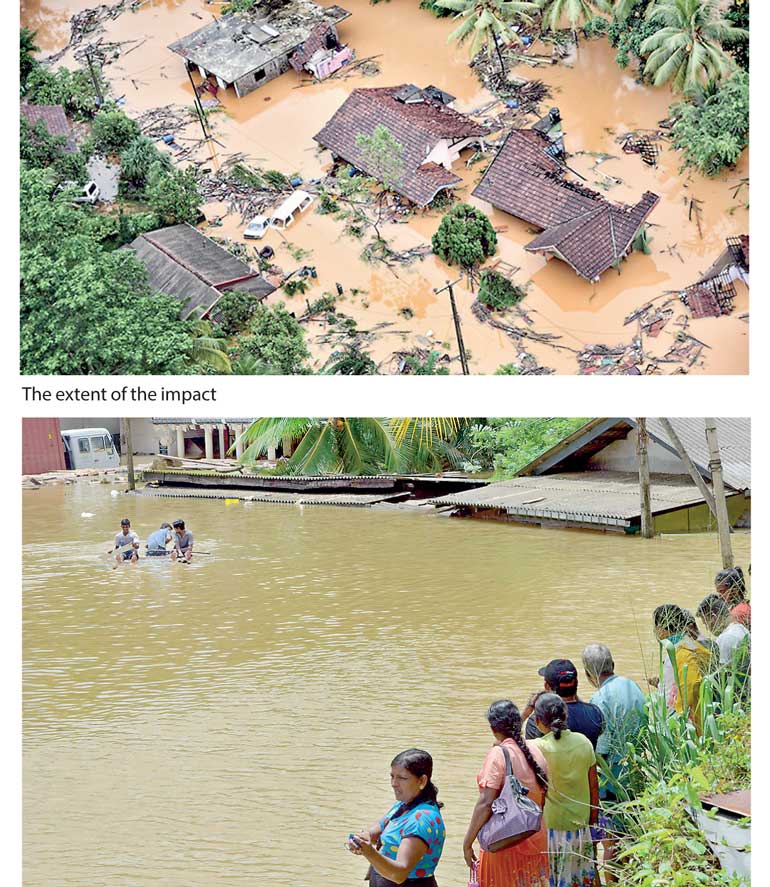A Brief Colonial History Of Ceylon(SriLanka)
Sri Lanka: One Island Two Nations
A Brief Colonial History Of Ceylon(SriLanka)
Sri Lanka: One Island Two Nations
(Full Story)
Search This Blog
Back to 500BC.
==========================
Thiranjala Weerasinghe sj.- One Island Two Nations
?????????????????????????????????????????????????Sunday, June 4, 2017

With Sri Lanka facing the worst-ever floods in 27 years, the Sri Lankan
economy has begun to feel the pinch of climate change. The Government
immediately appealed for foreign assistance to recover from the floods
that caused an estimated Rs. 300 billion or approximately $ 2 billion
worth of damage.
The worst flood coupled with deadly landslides in three decades claimed over 200 lives, damaging a staggering of 35,000 houses, with another 116 missing. Nearly 237,240 people have been displaced from their homes and have moved to 376 ‘safe locations’, including camps, schools, temples, community centres, with host families or in other temporary accommodation.
Unfortunately, the Minister in Charge of Disaster Management was in Mexico attending a conference when all this happened. Surely was he not warned of the cyclone in advance by the Meteorology Department? The Minister had gone to Mexico to give a speech about disaster management when a disaster was happening in the south of the country. Perhaps he should have taken the first flight home to coordinate the relief efforts.
The worst flood coupled with deadly landslides in three decades claimed over 200 lives, damaging a staggering of 35,000 houses, with another 116 missing. Nearly 237,240 people have been displaced from their homes and have moved to 376 ‘safe locations’, including camps, schools, temples, community centres, with host families or in other temporary accommodation.
Unfortunately, the Minister in Charge of Disaster Management was in Mexico attending a conference when all this happened. Surely was he not warned of the cyclone in advance by the Meteorology Department? The Minister had gone to Mexico to give a speech about disaster management when a disaster was happening in the south of the country. Perhaps he should have taken the first flight home to coordinate the relief efforts.
Flood control
 Time
and again both economists and sustainability experts have emphasised
the importance of environmental sustainability and flood control.
Despite the recent extreme weather patterns the ministry still does not
have a state-of-the-art monitoring system to track the weather and
water-level around the country.
Time
and again both economists and sustainability experts have emphasised
the importance of environmental sustainability and flood control.
Despite the recent extreme weather patterns the ministry still does not
have a state-of-the-art monitoring system to track the weather and
water-level around the country.According to Government sources the current flood has the capacity to have long time effect on numerous sectors of the economy—everything from agriculture to manufacturing to transportation. However, estimating flood losses is a time-consuming process.
Besides the obvious damage to public and private structures, other damages occur that are often hidden, appearing only after a few weeks. Examples include reduced fertility of farmland, weakened structural foundations of buildings, or waterlogged roads and bridges whose deterioration is exposed only during extreme weather. Other factors, such as transportation delays and increased volatility of crop and livestock markets, also must be accounted for and supported to come out of the crisis.
Preparedness
In the past few years we have seen an extraordinary spate of natural
disasters and extreme weather, including the collapse of the biggest
garbage dump in the country. The economic losses from these events have
been considerable: these calamities have cost the economy dearly in
terms of lost wages and output, utility disruptions, destruction of
public and private property, additional commuter time and transportation
costs and hundreds of lives.
Any type of disaster, however, can leave an economic imprint that lingers for years. Therefore we need to be better prepared to deal with it. Because natural disasters typically set in motion a complex chain of events that can disrupt both the local economy and, in severe cases, the national economy.
Calculating the damages of such an event can also be an onerous task because the cost of a natural disaster is ultimately wedded to several factors, and—more importantly—varies by type of disaster. Among the key influences are the magnitude and duration of the event, the structure of the local economy, the geographical area affected, the population base and the time of day it occurred.
Naturally, disasters that affect densely populated areas have the greatest potential for inflicting the most damage. Not only are large numbers of people endangered, but the potential loss to homes, businesses, highways, roads, bridges and utilities is also magnified.
Any type of disaster, however, can leave an economic imprint that lingers for years. Therefore we need to be better prepared to deal with it. Because natural disasters typically set in motion a complex chain of events that can disrupt both the local economy and, in severe cases, the national economy.
Calculating the damages of such an event can also be an onerous task because the cost of a natural disaster is ultimately wedded to several factors, and—more importantly—varies by type of disaster. Among the key influences are the magnitude and duration of the event, the structure of the local economy, the geographical area affected, the population base and the time of day it occurred.
Naturally, disasters that affect densely populated areas have the greatest potential for inflicting the most damage. Not only are large numbers of people endangered, but the potential loss to homes, businesses, highways, roads, bridges and utilities is also magnified.
Government response
Rebuilding and clean-up efforts must be done fast under a capable
minister. The crisis can generate temporary increases in retail sales of
such items as construction materials and non-perishable items,
resulting in prices moving up. Damaged or destroyed goods like clothing,
furniture and other household items need to be replaced, and roads,
bridges or other structures have to be repaired or rebuilt fast.
A factor influencing the recovery period is the timing and extent of disaster assistance monies from the centre and local governments. Although emergency funds for food and shelter are usually disbursed immediately by Presidential directive, monies for longer-term rebuilding efforts are often appropriated by the government with a substantial lag.
Finally, the percentage of total losses that are insured also affects the recovery. The lower the percentage of insured losses, the greater the dependency the local economy affected becomes on private and Government monies.
In the final analysis, we can no longer be stuck in an endless loop of unpreparedness. However it seems that we have not learned anything during the past couple of years. We still tend to be reactionary knowing very well that being proactive could minimise many of the deaths and damage to property and infrastructure.
A factor influencing the recovery period is the timing and extent of disaster assistance monies from the centre and local governments. Although emergency funds for food and shelter are usually disbursed immediately by Presidential directive, monies for longer-term rebuilding efforts are often appropriated by the government with a substantial lag.
Finally, the percentage of total losses that are insured also affects the recovery. The lower the percentage of insured losses, the greater the dependency the local economy affected becomes on private and Government monies.
In the final analysis, we can no longer be stuck in an endless loop of unpreparedness. However it seems that we have not learned anything during the past couple of years. We still tend to be reactionary knowing very well that being proactive could minimise many of the deaths and damage to property and infrastructure.
(The writer is a thought leader.)


